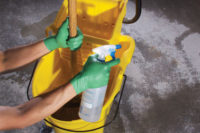
The FDA Center for Devices and Radiological Health is responsible for regulating medical devices, including gloves. The FDA has specific requirements about how gloves are manufactured and used; their standards generally relate to a glove’s strength, length, width, elasticity and freedom from pinholes. According to FDA guidelines, medical gloves should be watertight, have consistent sizing, and fit comfortably. FDA requirements also define performance properties, such as the minimum barrier protection and strength these products must exhibit.
Standards and test methods are developed by organizations such as the American Society of Testing and Materials as well as by various international groups. This helps ensure that tests are scientifically sound and that test methods fairly and accurately assess products made from a variety of manufacturing approaches, formulations and materials. Testing is conducted in a number of areas, including barrier protection, strength, biocompatibility and protection against microorganisms.
Barrier protection
All medical gloves must meet certain Acceptable Quality Level (AQL) standards related to the product’s freedom from pinholes and the barrier protection confidence level. A lower AQL number represents a higher quality product. For the purpose of a sampling inspection, the AQL is used by manufacturers to identify the maximum number of allowable defects (pinholes) per 100 units. Medical gloves inspected to an AQL of 2.5 must have fewer than 2.5 defects for every 100 gloves.
There are two tests used to verify AQL in gloves:
- The water leak test consists of filling a glove with 1,000 ml of water, suspending it for two minutes and then inspecting it for any leakage.
- The air inflation test consists of inflating the glove with compressed air and visually inspecting it for holes. One additional test — the Chemical Permeation Test — measures the medical gloves’ resistance to permeation by liquid or gaseous chemicals under conditions of continuous contact.
Strength tests simulate stress during actual usage. Glove strength is measured by resistance to tearing, puncturing and breaking, as well as by stretch ability. Testing typically covers tensile strength, elongation or elasticity, and puncture resistance.
Tensile strength is defined as the amount of force in pounds per square inch needed to stretch a medical glove until the breaking point. Higher numbers reflect superior performance. Elongation is how far the glove stretches before it breaks. For example, if a one-inch sample stretches to seven inches before it breaks, the elongation is 600 percent. A higher number is better because it indicates superior elasticity.
Selecting gloves suited to the risk
Healthcare workers need to be able to recognize the different glove types and apply them to the appropriate tasks and risk levels. In making a selection, it is necessary to:
- Evaluate the type and duration of the task to be performed.
- Examine the equipment to be used.
- Anticipate the potential for exposure to bodily fluids.
- Which medical glove type will provide the most effective barrier.
- Whether that barrier will remain intact under repeated hand movement.
- Whether the glove can withstand chemical exposure.
Vinyl gloves are appropriate for most low-risk, short-duration tasks — although the new third-generation synthetic vinyl gloves offer enhanced durability and protection. Low-risk exposure involves patient-care activities that require minimal glove use; minimal or no exposure to blood or body fluids; or times where gloves need to be worn for only short periods. Some examples are administering an injection, routine suctioning, caring for a patient, emptying a urinal and handling food.
Not all medical glove materials will meet the barrier requirements of all patient-care tasks and procedures. How gloves are used and how long they’re worn also will affect their barrier effectiveness. To determine how effectively certain medical gloves will perform, you can review the manufacturers’ specifications and any available test results.
Comfort is an important consideration
In addition to providing barrier protection, medical gloves should offer comfort. Gloves that fit properly can improve performance and reduce hand fatigue. For example, latex gloves have been shown to offer the most elasticity, strength and thickness, according to tests conducted by the American Society for Testing and Materials (ASTM).
Nitrile gloves are also a comfortable option because of their softness and flexibility, although they tend to be stiffer than latex. Nitrile is strong and resistant to solvents and causes less irritation. Vinyl gloves are naturally soft and comfortable, but provide a looser fit.
Don’t forget the cost
Finally, cost is a factor when considering which medical gloves to purchase. Latex and vinyl gloves are generally very affordable, while Nitrile and other types of synthetic gloves are usually more costly. Choosing the cheapest medical glove may not be appropriate to your situation, yet more expensive products may not fit your budget. The best approach is to choose the highest quality medical gloves that fit your needs at the best value.
